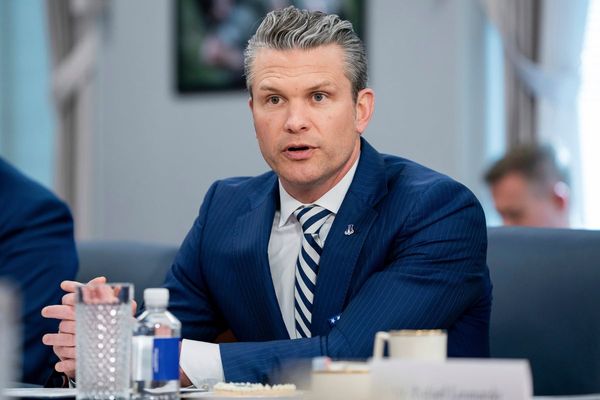
Shortly after being sworn in as the 47th president of the United States, Donald Trump signed a host of executive orders, including a move to end birthright citizenship as part of his hardline anti-immigration agenda.
Birthright citizenship refers to a constitutionally protected right that grants automatic US citizenship to babies born in the country.
The policy has been in place for more than a century and is enshrined in the 14th Amendment of the US Constitution, which grants citizenship to people “born or naturalised in the United States and subject to the jurisdiction thereof”.
But Trump has argued that the amendment does not include people whose parents are non-US citizens.
Here’s what we know about Trump’s order and how many people are going to be affected:
What does the order say?
Monday’s order sets out the parameters by which a person can claim a birthright.
It states that if one parent was “unlawfully present in the United States” and the other was not a citizen or a “lawful permanent resident at the time of said person’s birth”, the child cannot claim birthright.
It adds that if a parent’s presence in the country was “lawful but temporary” through a tourist, student or work visa and the other parent was not a US citizen, birthright citizenship would not be passed on to the child.
The order will come into effect on February 19.
What is birthright citizenship?
Following the US Civil War, Congress ratified the 14th Amendment in July 1868, which stated that all people born in the country were citizens. It was aimed at establishing full citizenship rights for Black Americans who suffered under slavery.
But the amendment has been interpreted to include all children born in the US, irrespective of their parents’ immigration status.
One of the most critical cases in the history of birthright citizenship came in 1898 when the Supreme Court ruled that Wong Kim Ark, born to Chinese immigrants, was a US citizen because he was born in San Francisco.
The Supreme Court ruled after the federal government tried to deny him re-entry into the country after a trip abroad under the Chinese Exclusion Act.
In 1924, Congress authorised citizenship for all Native Americans born in the United States.
“It’s ridiculous. We’re the only country in the world that does this,” Trump said on Monday after signing the order.
According to World Population Review, in 2024, at least 33 countries have birthright citizenship, predominantly in North America and Latin America, including Mexico.
How many children of immigrants have gained birthright?
According to the Pew Centre for Research, in 2022, 1.3 million US-born adults who live with their parents were born to undocumented immigrants.
Does the exclusion include H-1B work visa holders?
Yes, the skilled professional visa falls under the umbrella of work visas, and children of H-1B visa holders born in the US would not be able to claim birthright citizenship under the new executive order.
In 2023, 72 percent of H-1B visas, which have themselves come under criticism recently, were granted to Indian citizens, according to US Citizenship and Homeland Services.
Trump’s Make America Great Again (MAGA) base has been clamouring to end the H-1B visa, which Big Tech companies have used to hire skilled workers from abroad. Trump’s close ally, Elon Musk, has faced backlash from the MAGA camp, which accuses Big Tech firms of using the controversial visa programme to hire cheaper foreign workers at the expense of American workers.
Trump, who had tried to ban the visa programme during his first term, threw his weight behind Musk, saying, “It’s a great programme.”
“I also like very competent people coming into our country, even if that involves them training and helping other people that may not have the qualifications they do,” he said.
There are an estimated 600,000 immigrant workers in the US on H-1B visas, according to the Economic Policy Institute, a Washington, DC-based think tank.
However, on Tuesday, the US Department of State said that Secretary of State Marco Rubio had discussed “irregular migration” with his Indian counterpart, Subrahmanyam Jaishankar. Earlier this month, India’s Ministry of External Affairs spokesperson said the visa programme benefitted both countries.
Indians formed the third-largest unauthorised immigrant population in the US at 725,000 people, according to a Pew Centre for Research report from 2022.
Bloomberg reported on Tuesday that the Indian government has told the Trump administration it will work with the US to identify and take back its citizens in the country.
But the issue is going to test the strong bilateral ties between the two countries and likely affect public opinion in India, where Trump is viewed favourably due to his friendly relationship with Prime Minister Narendra Modi.
How many immigrant workers does the US have in total?
In total, the US workforce includes more than 30 million immigrant workers, according to the Pew Research Center. As of 2022, of these, 22.2 million are in the US on legal work visas, while 8.3 million are unauthorised migrant workers.
Those 22.2 million documented workers are in the US on a range of work visas: The US offers a set of 14 broad categories of work visas.
All of them would be impacted by Trump’s new executive order.
Has there been backlash following the order?
Trump’s order has faced pushback. Attorneys general from 22 US states filed lawsuits against Trump’s move to ban birthright citizenship on Tuesday.
The officials from the Democrat-led states have argued that birthright is engraved in the Constitution and cannot be changed.
“The president cannot, with a stroke of a pen, write the 14th Amendment out of existence, period,” New Jersey Attorney General Matt Platkin told The Associated Press news agency.
Connecticut Attorney General William Tong, a US citizen by birthright and the first Chinese American elected attorney general, said the lawsuit was personal.
“The 14th Amendment says what it means, and it means what it says – if you are born on American soil, you are an American. Period. Full stop,” he said.
“There is no legitimate legal debate on this question. But the fact that Trump is dead wrong will not prevent him from inflicting serious harm right now on American families like my own,” he added.
Critics of the birthright programme say it encourages immigrants to come to the US to acquire citizenship.
Republican House Science, Space, and Technology Committee Chairman Brian Babin, who will introduce the birthright bill to Congress this week, according to Fox News, said in a statement that the bill “corrects decades of misuse”.
“Citizenship is one of our nation’s most precious privileges. By introducing this legislation, we are taking an important step to restore integrity to our immigration system and prioritise the interests of American citizens,” Babin said.
White House Deputy Press Secretary Harrison Fields also said Washington was ready to face the states in court.
“Radical Leftists can either choose to swim against the tide and reject the overwhelming will of the people, or they can get on board and work with President Trump,” Fields said.
So far, New Jersey, as well as California, Massachusetts, Colorado, Connecticut, Delaware, Hawaii, Maine, Maryland, Michigan, Minnesota, Nevada, New Mexico, New York, North Carolina, Rhode Island, Vermont and Wisconsin have joined the lawsuit to stop the order.
Arizona, Illinois, Oregon, and Washington also filed a separate suit in federal court challenging Trump’s order.







